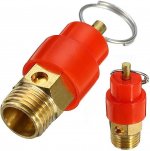ptonsparky
Tom
- Occupation
- EC - retired
You should be able to read the B40 if they are properly installed. I do not see it. Flip top to bottom.
agree95% chance this is not an electrical problem.
Yeah they are in the wrong wayYou should be able to read the B40 if they are properly installed. I do not see it. Flip top to bottom.
So, these should be flipped so that the ratchet wheel is facing inward towards the enclosure?Yeah they are in the wrong way
I hate to think of what is allowing him to reset it. I wonder if the motor is fried at this point
So if the pressure switch was jacked up, it would be taking too much current, I understand that. What should the pressure switch be limited to?Those heaters don't typically go bad, Check to see motor FLA on the nameplate. Then there should be a chart inside that motor starter to say what heaters you use for that motor FLA rating. Get the heaters installed the right way. Amp clamp each phase as the compressor is running until high pressure cutoff. Highest reading right before cuttoff is what you want to note. make sure it does not exceed nameplate FLA.
You probably want to check what the pressure switch is set at. I find all the time that someone has jacked up the pressure settings because of poor peformance od some piece of pnumatic equipment. Usually it's to compensate for resistance to flow due to the piping/lines being too small.
Is this a single stage or a two stage compressor?
They didn't. They allowed current to flow while the motor was in an overload condition. Guessing. Do a smell test of the motor.So, these should be flipped so that the ratchet wheel is facing inward towards the enclosure?
I wonder why they have worked all of these years the way they are in the picture?
Sent from my SM-G998U using Tapatalk
A suingle stage will have all one size cylinders, a two stage will have larger (primary stage) and smaller (second stage) cylinders. Usually factory settings on a single will be up to about 120psi and a two stage 150 - 200psi but not alwaysI don't know if this is a single stage or two stage. How do I tell?
Maybe it's just the nature of my business, but most I've changed are because I needed a different rating due to some change of operating conditions, machine relocation, different voltage, larger/smaller motor etc.Resetting these prior to a cool down can also destroy them. Particularly if done multiple times.
If they are reset prior to cooling down, the ratchet wheel may not be 'grabbed' tightly in the eutectic alloy (solder). The result is the wheel will turn freely so the overload relay keeps tripping. This condition can often be fixed by heating the thermal unit and then letting it cool.Resetting these prior to a cool down can also destroy them. Particularly if done multiple times.
Unless the overload relay is jumper out, I don't see how the motor ever ran. The ratchet lever has to be held down by the gear on the overload element for the overload relay to close and let the contactor pull in.From what I was told, they had never been replaced, and since I thought they were the problem. I replaced them. When I did, I installed the new ones just as the old ones were, which is what you see in the picture. After installing the new ones, I depressed the red reset button in order for the motor to work.
It worked for a while but then started tripping again, just as the old ones were doing. It seems like the problem isn't related to the overload heaters because it's acting the same as when the old ones were in. It is an intermittent trip, and the owner was wondering if it had to do with high ambient temperatures outside.
I still need to get back there to get the nameplate info, etc.
Sent from my SM-G998U using Tapatalk
I was wondering that myself. I was thinking something was jammed. Whatever it is jammed or jumpered, that thing isn't protecting the motorI don't see how the motor ever ran.


It looked like from the picture ratchet lever was not contacting the gear the best I could see, it may have still been in the tripped position when the picture was taken, or as you said, the OL block was bypassed. But what would be shutting it down? Since the op said it was intermittent, I would say it was the relief valve stuck closed on the head or pressure switch, so it’s trying to restart with full pressure on the head.Unless the overload relay is jumper out, I don't see how the motor ever ran. The ratchet lever has to be held down by the gear on the overload element for the overload relay to close and let the contactor pull in.
That was one advantage of that overload design...you couldn't install them backwards and have the motor run like you can with the bi-metallic ones. Also, they take more time to cool before you can reset than the bi-metallic ones.


